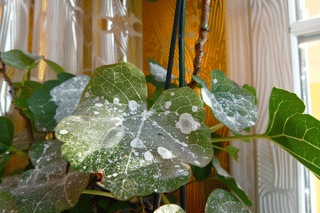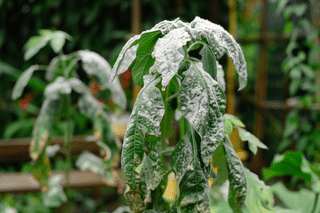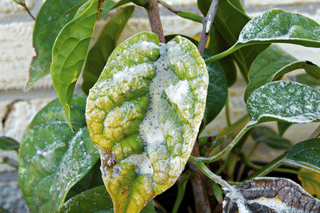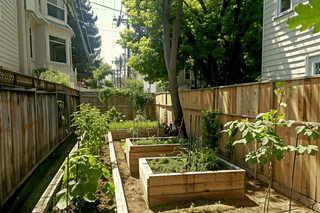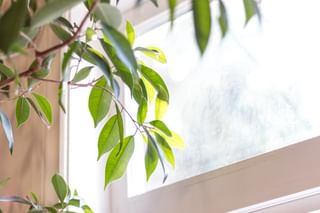What is powdery mildew on plants?
Learn about powdery mildew, its effects on your houseplants, how to effectively remove it from your indoor garden, and how to prevent it from showing up in the future to keep your plants healthy.
Do you know what's a plant lover's worst nightmare? Spotting that powdery mildew on your precious houseplants. It might look harmless at first, but it can cause some serious issues if you don't deal with it. But what exactly is powdery mildew, how does it affect your houseplants, and most importantly, how can you get rid of it from your indoor garden?
Let's learn a bit more about powdery mildew and what we as plant parents can do to help our plants.
What is powdery mildew?
Powdery mildew is a fungal disease that can hit plants both inside and outside. It shows up as a white, powdery film on leaves, stems, and flowers. But it's not just about looks; this fungus weakens plants by messing with their photosynthesis and nutrient production.
What does it look like?
Powdery mildew stands out because it looks like someone dusted your plants with powder. It's different from other fungus issues because it doesn't need wet leaves to spread. Instead, it loves hanging out in humid places that aren't too hot or cold. This means your nice, tidy indoor garden might be its favorite growing spot.
Look out for these signs:
- White, powdery spots on plant surfaces
- Fuzzy, mold-like growth on leaves
- Dry and withered plant tissues
How powdery mildew harms a plant
Don't let the fluffy look of powdery mildew trick you, it's a real threat to your plants, signaling trouble ahead. If the powdery mildew doesn't kill your plant by itself, it will weaken your plant so it becomes susceptible to other pests.
Let's look at a few different ways powdery mildew can harm your plant.
It blocks photosynthesis
The white to grayish powder on your plant's leaves messes with the plant's ability to do photosynthesis, which is a term for how plants use sunlight to make food from carbon dioxide and water. When the leaves get covered, they can't soak up as much sun, and that leads to weaker plants.
It feeds on your plant
Powdery mildew fungi feed on your plant and it's energy supply. They send out these things called haustoria right into the plant's skin cells to steal nutrients. This means the plant gets less of what it needs to grow and stay healthy.
Leaf damage and drop
The infection makes the leaves turn yellow, brown, or get all twisted, causing them to fall off earlier than they should. This messes with the plant's ability to soak up sunlight and make food, and it also weakens the plant, making it easier for other problems to hit it harder.
It becomes susceptible to other pests
When plants get infected, they're not at their best. They can easily catch other diseases and pests. Dealing with a powdery mildew infection stresses them out, making them even more likely to struggle with stuff like temperature changes and not getting enough water.
Stunted growth
When plants get infected, they have to use their energy to fight off the infection instead of growing and reproducing. This means they end up growing less and not reproducing as much.
As you can see, powdery mildew can have quite a serious effect on your plant if you don't treat it. But before you can treat your plant, you'll need to know why it's on your plant in the first place. Without knowing why this fungal infection is on your plant, you can't get rid of it permanently.
So let's find out what causes powdery mildew to grow on your plant.
The causes of powdery mildew growth
Powdery mildew spores spread through the air and can be carried by the wind over long distances. The disease can pop up out of the blue, but stuff like where you are and what you do can ramp up its chances of showing up.
High humidity
The leaves of your plant don't have to be wet for powdery mildew to grow and spread, like most other fungal diseases. High humidity is what helps powdery mildew spores to grow. But here's a twist: if your plant stays wet for too long, it's bad for the spores.
Moderate temperatures
Powdery mildew loves hanging out in mild weather, usually when it's between 68℉ and 81℉ (20℃ to 27℃). You'll find these conditions mostly in spring, summer, and autumn.
Poor air circulation
Areas with poor air circulation on to can create microclimates that hold onto these higher humidity levels. The powdery mildew spores love this and thrive in these areas.
Shade
Shaded areas are usually a little cooler and more humid than those spots in the bright sunlight. This provides an ideal environment for powdery mildew to grow.
Weakened plants
Some plants are just more likely to get powdery mildew than others. If you pack them too close and they can't get enough air, or if they're stressed from too little or too much water, not enough nutrients, or other issues, they're more prone to problems.
Now that you know how powdery mildew harms your plant and what causes it to be interested in your plant, we can treat the infection to remove it from your plant.
Treating powdery mildew on plants
If you've noticed the signs of powdery mildew showing up, it's time to take action! Don't wait too long with this, as this could harm your plant more. There are ways to get control and remove this fungus from your plant.
Step 1: Remove affected leaves
Carefully cut off leaves that have white, powdery spots. This stops the disease from spreading.
Step 2: Use sunlight
Place your plant in a sunny spot. Powdery mildew does not like sunlight. But, make sure the plant type can handle more sun.
Step 3: Water correctly
Water your plant at the soil level, not from above. Wet leaves can make powdery mildew worse. Always water in the morning so leaves dry during the day.
Step 4: Increase airflow
Make sure your plant has space around it for air to move. Good airflow helps keep leaves dry and reduces mildew growth.
Step 5: Use a spray to kill the fungus
There are a few different sprays you can try out, ranging from natural to chemical solutions. Start with the natural solution as this is the least harmful to your plant and "good" bacteria. Move on to the chemical solutions if you notice the natural ways aren't working for you. Try these solutions:
A mildew spray
Mix 1 teaspoon of baking soda with 1 quart of water and a few drops of liquid soap. Spray this mixture on the leaves. It helps control mildew.
Milk spray
Mix 40% milk with 60% water. Spray it on your plant every week. Milk can help prevent and control powdery mildew.
A commercial fungicide
If natural methods don't work, you can use a fungicide made for plants. Follow the instructions on the label carefully.
After all of these steps, you've probably saved your plant from this tough fungus. But removing it once doesn't mean it won't come back. So we'll also need to take a few steps to prevent powdery mildew from showing up again in the future.
Preventing powdery mildew
You know how they say prevention is better than cure? That's true for taking care of houseplants, too. If you take a few steps so powdery mildew doesn't feel too comfortable around your plants, you're already winning.
Let's see what you can do to prevent powdery mildew on your plants!
Keep the humidity in check
The most important thing to prevent powdery mildew from growing on or around your plant is to keep the humidity levels high enough for plants to thrive, but not so high that powdery mildew thinks you created a nice home for it.
Stick to humidity levels around 50-60%.
Improve airflow
There are a few ways you can improve the airflow around your plant and the air circulation in your living spaces. One of the easiest ways is to prune leaves if your plant is especially bushy, don't place plants too close to each other, and open a window from time to time.
Sunlight
Last but not least, the biggest enemy of powdery mildew: sunlight. Sunlight makes the environment warmer and drier, something powdery mildew doesn't like. So make sure to move your plant to a brighter spot. This brighter spot will also help your plant grow more easily, so that's a nice bonus.
Conclusion
Dealing with powdery mildew on houseplants might seem tough at first, but honestly, it's manageable. First, figure out what causes it, then dive into treating and preventing it effectively. You've got this!
Remember, being consistent is important, both for treatment and prevention. Keep an eye on your plant's environment as it makes a huge difference in keeping them healthy and vibrant. By sticking to these tips, you're not just fighting off powdery mildew; you're making sure your plants thrive at home.
Thank you for reading this post! I hope it helps you to keep your plants healthy and beautiful! If you're looking for more guides on specific plants, you can always request a plant guide to get a guide for the plant you have trouble with.
Test your plant care knowledge
Quiz completed!
Want to learn more? Sign up for my newsletter to receive free tips in your inbox!
Sign up now!